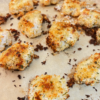
What you need to know about Candida
Hello Candida! This has become a booming health topic and condition that tons of people are struggling with. In this post, we are covering what Candida is, symptoms of Candida overgrowth, foods to eat and foods to avoid, as well as other approaches to treating Candida overgrowth.
What is Candida?
Candida is a type of fungus naturally found in your body and plays a role in nutrient absorption and digestion. However, Candida levels can get out of balance due to overgrowth resulting in undesirable symptoms and in some cases serious illness. Candida overgrowth can present in different parts of the body, including your mouth, GI tract, vagina, skin, and in more severe cases, the blood. The cause of Candida overgrowth is widespread, ranging from certain medications to a poor diet.
Possible Causes of Candida:
- Gut dysbiosis (imbalance of good and bad bacteria – likely due to the use of antibiotics)
- Medications (birth control pill & oral corticosteroids)
- Underlying health conditions (diabetes & autoimmune conditions)
- Poor diet (think: high sugar, refined cars, alcohol)
Symptoms of Candida Overgrowth:
Given that Candida overgrowth can occur in various places throughout your body, the symptoms of candida overgrowth are widespread.
Candida Overgrowth Symptoms:
- Thrush (white patches inside the mouth or around the lipids)
- Frequent vaginal yeast infections or sinus infections
- Digestive issues (bloating, constipation, diarrhea, food sensitivities)
- Skin Issues (eczema, psoriasis, hives, and rashes)
- Nail and fungal infections
- Severe seasonal allergies
- Chronic fatigue and exhaustion
- Joint Pain
- Brain Fog
- Changes in mood (irritability, mood swings, anxiety, or depression)
- Hormonal imbalances
- Excessive cravings for sugar and refined carbohydrates
Foods that feed Candida
If you have Candida overgrowth, there are a bunch of foods you want to avoid or limit when possible for a period of time to heal. Candida is unique in that it actually feeds off of sugar, so avoiding foods with excess sugars is critical to starve off the Candida.
Foods that feed Candida:
- Added sugars and artificial sweeteners
- Alcohol (especially wine & beer)
- Refined white carbohydrates (think: white flour, white pasta, white rice, cereals, sweets)
- Gluten
- Dairy
- Fermented foods
- Dried fruit and packaged fruit juices
- Yeast products (think: breads, baked goods, pretzels)
Remember, the goal here is to limit or remove these foods for some time (not forever) while you work to flush the Candida out of your system.
What should you eat if you have Candida overgrowth?
There’s a lot of information about the “Candida Diet” or what you should eat if you have Candida overgrowth. The bottom line is to avoid added-sugars and refined carbohydrates when possible and focus on whole-foods such as proteins, fats, and non-starchy veggies.
Candida friendly foods:
- Non-starchy vegetables (kale, cabbage, spinach, beets, greens)
- Healthy fats (avocados, nuts, seeds, olive oil, fatty fish)
- Gluten-free grains (brown rice, quinoa, millet)
- Beans (you pick!)
- High quality proteins (think: wild caught, grass fed, pasture-raised, organic – if possible)
- Lower glycemic fruits (berries, citrus, cherries, pears, apples)
- Fresh herbs and spices
- Vegetable juices (leafy greens, cucumber, celery, ginger, lemon, carrots, fennel)
In general, I suggest trying to increase these foods throughout the day for a couple of weeks while decreasing (or eliminating) foods that feed candida and see how your body reacts. Note that it can take a bit of time to notice results, but stick with it!
Other treatment method for Candida
While I like to focus on foods first, it is important to mention other methods are used to treat Candida alongside diet (depending on the person and severity).
- Antimicrobial Herbs (likely some combination of berberine, grapefruit seed extract, oregano oil, garlic, ginger, and caprylic acid)
- Prescription antimicrobials (in more severe cases)
- Probiotics
- Lifestyle changes (think: manage stress, improve sleep quality)
The Bottom Line
Candida overgrowth is tricky as it presents differently from person to person. In most cases, Candida overgrowth can be addressed by a change in diet for a period of time – sometimes alongside other methods. Working with a health professional is highly encouraged to get to the root cause of your Candida and symptoms to maximize your results.







